Bedford, Bedfordshire
Up to 1834
A number of early workhouses were in operation in the Bedford area. The early workhouse directory, An Account of Several Workhouses..., first published in 1725, listed parish workhouses in operation in three of Bedford's five parishes (St Cuthbert, St Mary, and St Paul), and also at Kempston, Steventon [Stevington], and Turvey. The largest of Bedford's workhouses, St Paul's, was described as follows in a report dated September, 1724:
8 old Persons, and
13 Children
---
21
THEIR Bill of Fare allows three Flesh Days in the Week, and in other Respects is much the same as in other Places.
THEIR Bread is Wheat dressed down, and made into large Houshold Loaves, by a Woman in the House. Their Drink is Beer tunn'd in from the publick Brew-house, at three half-pence per Gallon. The Overseers do sometimes put a Cow upon the Common for them and that nothing may be wasted or lost, they have a Pig or two brought in, to live upon their Wash, and Dregs, and Fragments; which when well grown, is fed and killed for the House. They have alto a little Garden for Herbs, Onions, &c. In their Yard they contrive to hang Lines, and lay clean Brush Faggots where they dry their Cloaths; and such old Women as can do nothing else, spin Hemp for Sheets, and other Uses. The Women that are able are generally let to washing Cloaths, cleaning Rooms, making Beds, and nursing the youngest Children. The Boys and Girls that can work, are let to spin Jersey for the Drapers, who pay them by the Pound for their Work. As soon as they are grown up, they are bound out Apprentices. Before they can do any Work, they are sent to the Charity-School, and taught to read and learn their Catechism. And the Minister of the Parish is so good, as to look in sometimes, and recommend to all of them a due Care of their Morals, their Duty to the King, and Magistrates ; that the Elder set good Examples to the Younger; that Morning and Evening the Children be taught their Prayers ; and that no Rudeness be seen among them. The older People creep out to Church upon Prayer-Days, and a large Pew is erected by the Churchwardens for all the Poor that will come on Sundays. They did use to come with the Master in pretty decent manner to Church on Sunday Mornings, but the Master is lately dead.
BEFORE this House was set up, the Assessments for the Poor were yearly from four Shillings in the pound to five, which did commonly amount to 3001. per Annum. But since the Parish fell into this Method, the Disbursements were reduced in 1721, to 197 l 11 s. 0 d.½. In 1722, to 177 l. 5 s. 7 d ¾.
The Workhouse Rules for the same establishment are also recorded:
I. THAT the Directors have Power to nominate and appoint a Master and Mistress well qualify'd for that Trust.
II. THAT no Persons be taken in, or partake of the Provisions of the House, without Order from a Justice of Peace, or the Overseers for the time being, upon pain of Exclusion.
III. THAT the Overseers do direct the Master and Mistress to take particular Care of all Persons, old and young, who are admitted, and capable of Work, that they be taught and made fit for some Trade, and daily employ'd in Work or Service.
IV. THAT the Poor who are well and healthful, be duly kept to their Work, according to the usual Working Hours of Handicraft Trades, being allow'd sufficient Respite for their times of Eating : And if any such Person refuse to Work, the Master or Mistress to acquaint the Overseers, that such able, but disorderly idle Person, may be corrected according to Law.
V. THAT none of the said Person do absent themselves from their Work upon any Pretence whatsoever, without the Leave of the said Master or Mistress; and if upon any reasonable Cause, as Charing, Day Labour, or the like, they are permitted to go out, and afterwards are found begging, or loitering up and down, to avoid their proper Business in the said House ; that Complaint be made to a Justice of Peace of such evil Practice, and the Offender accordingly corrected.
VI. THAT it be the proper Business of the Overseers for the Time being, to buy in and deliver to the Said Master or Mistress all manner of necessary Provisions for Eating, Drinking, Cloathing, Bedding, Firing, &c. for the said poor People, and also to provide such Stock of Goods or Wares, as are proper and sufficient to keep them to Work, and carry on some beneficial Manufacture, within the said House, as will best turn to Account. And that the said Overseers do keep a Book, or Books of Entry, of Goods bought, and of the Peoples Work within the said House, and of the Improvements of the said Stock. And that any five or more of the Directors be at all times admitted to inspect the Books; and that the said Accounts be brought to the Vestry with the Monthly Expence, to be examined.
VII. THAT none do receive Collection of the Parish, but such as are within the Workhouse, excepting such as thro'' Sickness or Largeness of their Families, or other Straitness of Circumstances and Incapacity, are judg'd fit to receive a little Relief upon some Emergency, or in case of Pestilential Diseases, Lunacy, or the like; of all which, the Overseers or Juices to be the proper judges.
VIII. THAT the Directors, or any two of them, as often as they judge it needful, do meet at the said Workhouse, and examine into all Disorders of the Poor, and into the Management of the Master and Mistress, and see that due Care be taken for all manner of wholesome, necessary and sufficient Provisions. And also to hear the Complaints and real Grievances of the Poor.
IX. THAT the Master and Mistress take Care that all the poor People be kept clean and neat in their Persons and Apparel, and the Children be taught and instructed in civil and good Behaviour, in Reading, Knitting, Spinning, Sewing, and other kinds of domestic and honest Labour, and take Care of their own Examples ; and see that all of them who are able do repair to some Place of religious Worship, upon the Lord's-Day ; and be instructed Morning and Evening in their Prayers; and that no immorality, or Profaneness, or Rudeness, be allowed in the House; nor the Poor suffered to wander idly, but religiously observe the Lord's-Day.
X. THAT the said Master and Mistress do take Care that no Goods or Work that shall be done or wrought in the House, be embezzled, nor Provisions or stores be improvidently wasted, or suffered to putrify or gather Uncleanness, or any other Way be misapplied. And it any such Embezzlement, or ill Houswifry shall be detected, then Complaint shall be made by the Master or Mistress, or any other Person aggrieved, against the Party offending, to one or more Justices of the Peace, that such Disorders may be punished, and further Damages may be the sooner prevented.
XI. THAT the Faults and Disorders of the Said poor People, whether old or young, who refuse or contemn the Reproofs of the Mailer or Mistress, or utter ill Language against them, or neglect their Instructions, be recorded in a Book to be kept for that purpose ; and laid before the Directors or Overseers, that, by their Authority and Admonitions, Rudeness, Wickedness and Dishonesty may be restrained, and Peace and good Order maintained ; and that a Magistrate be sollicited to punish all obstinate, perverse and unruly Person , according to their Crimes.
Roxton opened a workhouse in around 1739 (Hitchcock, 1985).
A parliamentary report of 1777 recorded parish workhouses in operation at Bedford—St Paul (for up to 60 inmates), Cardington (20), Kempston (30), and Thurleigh (12).
A row of cottages on the High Street in Pavenham once served as the parish workhouse and overseers' house.
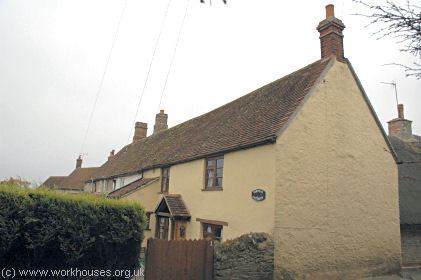
Pavenham former overseers' house and parish workhouse, 2005.
© Peter Higginbotham.
The parish workhouse in Kempston was once a row of cottages at Church End.
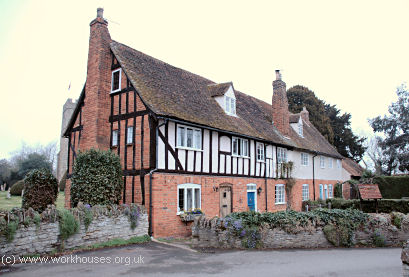
Kempston former parish workhouse, 2005.
© Peter Higginbotham.
The parish workhouse at Cardington was erected by subscription in 1757 on The Green.
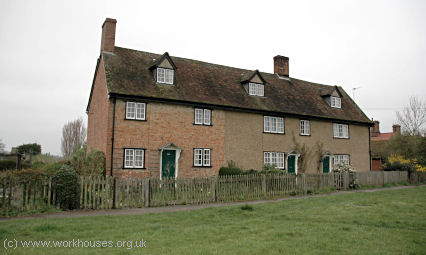
Cardington former parish workhouse, 2005.
© Peter Higginbotham.
The Bedford House of Industry, a three storey red-brick building, was erected in 1795-6 on the south side of Kimbolton Road in Bedford. The architect was John Wing. The manufacture of flannel 'on an extensive scale' took place at the institution.
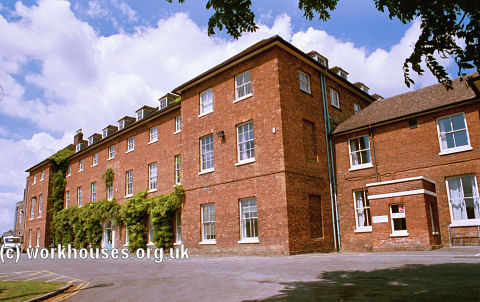
Bedford main block from south-east, 2000.
© Peter Higginbotham.
Great Barford had a workhouse just to the north-west of the village, at the end of what is now Peashill Lane.
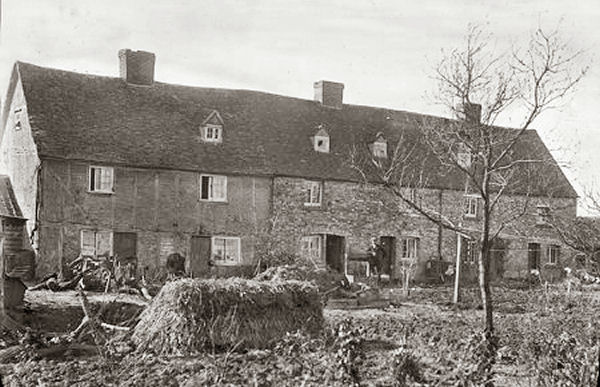
BGreat Barford workhouse, date unknown
After 1834
The Assistant Poor Law Commissioner assigned to Bedfordshire, Daniel Adey, had originally wanted to create a large union of 101 parishes centred on Bedford, and making use of Bedford's existing large and efficient workhouse. However, there was strong resistance from local estate owners who much preferred smaller unions where they exert more influence. As a result, four smaller unions were created at Bedford, Ampthill, Biggleswade, and Leighton Buzzard.
The Bedford Poor Law Union was officially formed on 21st September 1835. Its operation was overseen by an elected Board of Guardians, 45 in number, representing its 44 constituent parishes as listed below (figures in brackets indicate numbers of Guardians if more than one):
Bedfordshire:
Bedford — St Paul's (2), Bedford — St Peter, Bedford — St John, Bedford — St Cuthbert, Bedford — St Mary, Biddenham, Bletsoe, Bolnhurst, Bromham, Cardington, Carlton, Chellington, Clapham, Colmworth, Cople, Eastcots, Elstow, Felmersham-cum-Radwell, Goldington, Great Barford, Harrold, Kempston, Keysoe, Knotting, Melchbourn, Milton Ernest, Oakley, Odell, Pavenham, Ravensden, Renhold, Riseley, Roxton, Sharnbrook, Souldrop, Stagsden, Steventon [Stevington], Thurleigh, Turvey, Wilden, Wilhampstead, Willington, Wootton, Yielden.
Later Addition: Colworth Farm (1858).
The population falling within the Union at the 1831 census had been 28,033 with parishes ranging in size from Chellington (population 119) to Bedford St Paul's (3,956). The average annual poor-rate expenditure for the period 1832-34 had been £25,716 or 18s.4d per head of the population.
In 1835, the Bedford House of Industry was let on a perpetual lease to the Bedford Union Board of Guardians. In 1836, the Poor Law Commissioners authorised an expenditure of £1,800 on its enlargement. It could then accommodate up to 400 inmates.
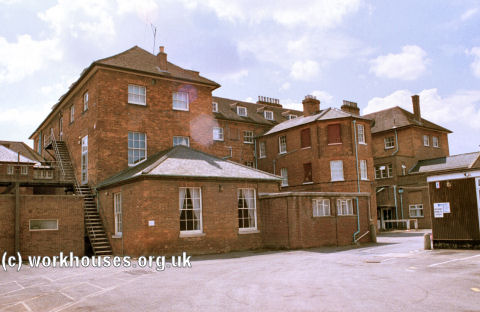
Bedford from the north-east, 2000.
© Peter Higginbotham.
The workhouse location and layout can be seen on the 1901 map below.
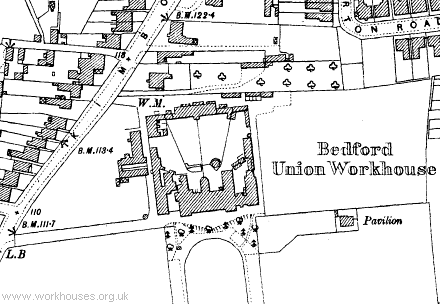
Bedford workhouse site, 1901.
A chapel was added at the east of the workhouse in the early 1900s. Further building in 1914-18 included an infirmary (later the maternity department) to the north of the workhouse, and lunatic observation wards to the north of the chapel.
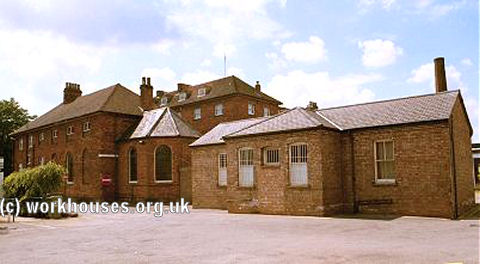
Bedford chapel and lunatic observation wards from the north-east, 2000.
© Peter Higginbotham.
Affairs at the workhouse received some publicity in October 1894 when a member of the Board of Guardians, the Rev. W. P. Beckett, proposed moved that a small committee be appointed to inquire into "certain alleged irregularities" of the master in the conduct of the house. After much discussion, members of the press were asked to withdraw while the matter was discussed "in camera". A subsequent report only hinted at the allegations that had been made: "This Committee is of opinion no such serious charge of irregularity has been made against the master as to allow the board to appoint a committee to make further investigation, but the committee have to recommend that in future no milk be skimmed without the order of the board or the medical officer, and if fowls or other substitutes for meat be made the reason should be entered in the provision account." In a subsequent letter to the Bedfordshire Times Mr. Beckett said:
In 1894, the British Medical Journal set up a "commission" to investigate conditions in provincial workhouses and their infirmaries. Following a visit to Bedford, the commission's report found that although the buildings and space available for treating the sick were ample, there was a notable indifference and lack of thought in the way that the inmates were cared for. For example, the sole nurse employed on the female wards also acted as an assistant to the matron and was frequently called away for matters such as supervising the bathing of the able-bodied women, or the weighing out of ingredients for dumplings. In the nursery, a "miserable little room", there were no toys and the children were "a sorry, sickly lot" reminiscent of London slum children. Further details are available in the full report.
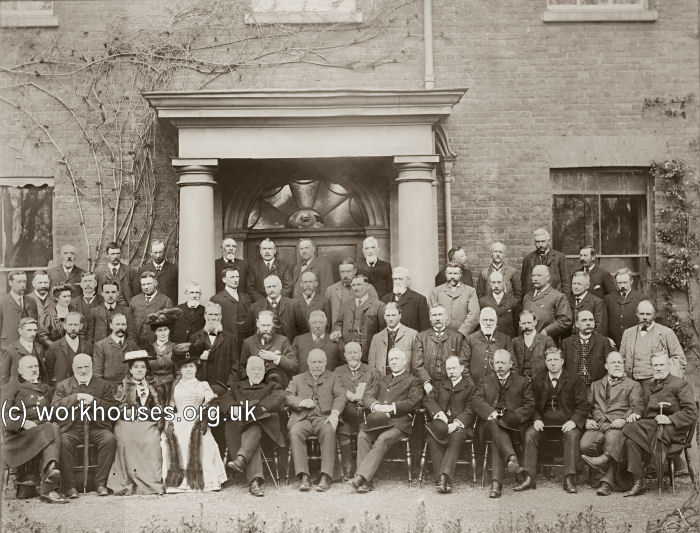
Bedford Board of Guardians, April 1907.
© Peter Higginbotham.
Between 1929 and 1948, the former workhouse was known as St Peter's Hospital. After the inauguration of the National Health Service it became the North Wing of Bedford General Hospital. Almost all of the later buildings were demolished in 2007 leaving only the original 1795 main building, now known as as Shires House. On the night of 3 January 2019, the then disused building was gutted by a fire which is believed to have been started deliberately.
Kempston Lodge Children's Home
In around 1910, the Bedford Guardians converted a property known as Kempston Lodge, on Bunyan Road, Kempston, for use as a home for up to 50 children. Although referred to by the Union as a 'Cottage Home', the old house was more akin to what is sometimes described as a 'Small Home'. The property remained in use as a children's home until around 1992.
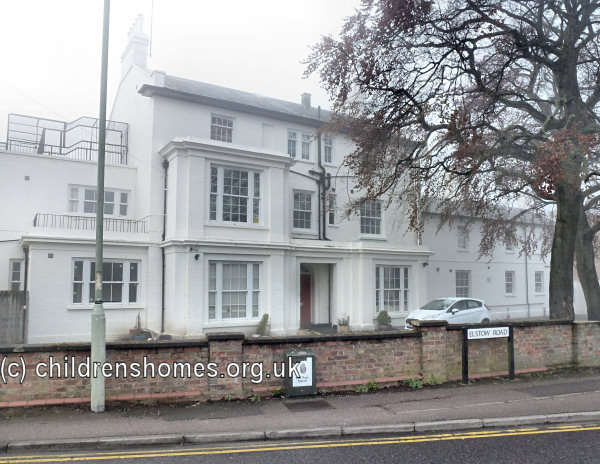
Former Kempston Lodge Children's Home, 2014.
© Peter Higginbotham.
Staff
Inmates
Records
Note: many repositories impose a closure period of up to 100 years for records identifying individuals. Before travelling a long distance, always check that the records you want to consult will be available.
- Bedfordshire and Luton Archives and Records Service, Borough Hall, Cauldwell Street, Bedford. MK42 9AP. . A variety of records survive including: Guardians' minute books and ledgers (1835-1930); Birth registers (1836-57); Death registers (1835-57, 1915-45); Outdoor relief lists (1875-1920); Punishment book (1896-1912); Register of infirmary patients (1854-90); etc.
- Ancestry
has Bedfordshire Workhouse and Poor Law Records (1835-1914) available online.
Bibliography
- Private Charity and the Public Purse by Bernard Cashman (1988)
- Hitchcock, T.V. (1985) The English workhouse: a study in institutional poor relief in selected counties. l695-l750. (DPhil thesis. University of Oxford.)
Links
Unless otherwise indicated, this page () is copyright Peter Higginbotham. Contents may not be reproduced without permission.


